Bringing a new dog into your home is an exciting journey, and choosing the right breed is the first crucial step. If you’re pondering, “I need a dog,” but feel overwhelmed by the vast options, especially in India, this guide is designed to help. Understanding the popular types of dogs in India, complete with their pictures and names, can provide valuable insight into finding a loving, loyal, and affectionate companion that perfectly suits your lifestyle. The demand for various dog breeds has consistently grown in India over the years, and knowing their specific characteristics can make your decision much easier. You might also want to explore other breeds like the show me a picture of a bull terrier dog to broaden your options beyond this list.
This comprehensive overview will delve into some of the most sought-after breeds, detailing their history, key features, temperament, exercise needs, grooming requirements, and potential health conditions. Whether you’re a first-time owner or looking to add another furry friend to your family, getting to know these breeds will equip you with the knowledge to make an informed choice. From formidable guardians to playful companions, India’s dog lover community embraces a diverse range of canine personalities and sizes.
Popular Dog Breeds in India: Detailed Profiles
India is home to a wide array of dog breeds, each with its unique charm and needs. Here, we explore some of the most popular choices among Indian households, offering a glimpse into what makes them so beloved.
German Shepherd
The German Shepherd stands out as one of India’s most unique dog breeds, celebrated for its intelligence, obedience, and unwavering loyalty. These dogs are confident and courageous, making them exceptional companions and protectors for many families across the country. Their distinct appearance and trainable nature contribute significantly to their enduring popularity.
 A majestic German Shepherd dog with a tan and black saddle coat, standing alertly
A majestic German Shepherd dog with a tan and black saddle coat, standing alertly
A Brief History – Originally known as Alsatians, German Shepherds were bred to assist shepherds in herding and protecting sheep. Far from being mere pets, they served as invaluable helpers to farmers in Germany, where the breed first gained prominence during the First World War. Their rich history as working dogs is a testament to their intelligence and versatility.
| Features | Details |
|---|---|
| Size | Large |
| Height | 21 to 25 inches |
| Weight | 35 to 45 kilograms |
| Characteristics | German Shepherds are agile and strong, featuring square heads and erect, pointed ears. They possess long, bushy tails, and their double coats can range from tan with a black saddle to solid black or even white. This medium-length double coat is known for shedding, which requires consistent grooming. |
| Group | Herding Group |
| Temperament | Intelligent, self-assured, obedient, protective, alert, and active dogs |
| Exercise | Being active and athletic, German Shepherds require substantial daily exercise to maintain both mental and physical well-being. Regular activity helps prevent boredom and ensures they remain healthy and engaged. |
| Grooming | Due to their propensity for shedding, daily brushing is essential for German Shepherds, especially twice a day during shedding season, to minimize loose hair around the home. They also need baths every 10 to 15 days. Regular nail trimming is crucial to prevent pain and other issues that can arise from overgrown nails. |
| Health conditions | This breed should be screened for conditions like degenerative myelopathy and hip and elbow dysplasia. They are also susceptible to bloating or gastric dilatation-volvulus (GDV), a life-threatening condition if not detected and treated promptly. |
| Food Doggie Dabbas Recommends | High-Value Training Treats, Sardine Oil, Hemp Seed Oil, Fresh Meals (Mutton & Parsley, Chicken & Mint, Fish & Dill, Chicken & Pumpkin), Chicken Jerky, Liver it Up, Fish Ferky. |
Great Dane
For individuals with a preference for larger canines, the Great Dane is an exemplary choice. These magnificent dogs are not only affectionate companions but also vigilant and fierce guardians of the home. Renowned for being among the tallest dog breeds globally, they command respect and admiration wherever they go. In fact, a Great Dane named Zeus once held the record for the tallest dog in the world.
 A tall and lean Great Dane, standing gracefully with its distinctive muscular body
A tall and lean Great Dane, standing gracefully with its distinctive muscular body
A Brief History – Originating from Germany, the Great Dane’s lineage dates back over 400 years. Descending from mastiff-like dogs, they were historically celebrated for their prowess in hunting wild boars. These impressive dogs were primarily assets of the nobility, utilized for sport and for safeguarding carriages and sprawling estates.
| Features | Details |
|---|---|
| Size | Large |
| Height | 29 to 33 inches |
| Weight | 60 to 90 kilograms |
| Characteristics | Great Danes are distinguished by their long, muscular bodies and strong necks. They have medium-length tails and are generally light to medium shedders. Their powerful physique belies a gentle nature, making them a unique combination of strength and grace. |
| Group | Working Group |
| Temperament | Friendly, reserved, confident, docile, gentle, and devoted |
| Exercise | Daily exercise is a requirement for Great Danes, though the intensity should always be age-appropriate. It’s crucial to avoid rigorous exercise for puppies, as this can harm their growing joints. Outdoor exercise on proper ground is recommended, as limiting physical activity to hard surfaces like marble or tiled flooring can lead to long-term negative impacts on their joint health. |
| Grooming | Dogs of this breed have a smooth coat and do not shed excessively. Weekly brushing is usually sufficient to manage any loose hair. They only need occasional baths, and their nails must be kept short to prevent discomfort and difficulty in movement. Consistent grooming helps maintain their sleek appearance and overall health. |
| Health conditions | Great Danes are highly susceptible to bloat (gastric dilatation-volvulus or GDV), which is a life-threatening emergency. Many owners, under veterinary guidance, consider prophylactic gastropexy surgery to mitigate the severe effects of GDV. This breed should also be screened for hypothyroidism, various cardiac diseases, and hip dysplasia to ensure their long-term health. |
| Food Doggie Dabbas Recommends | Chicken Jerky, Fish Ferky, Berryblast Cheese Jerky, Blueberry Chicken Jerky, Chicken & Pumpkin, Cottage Cheese & Carrot, Fish & Dill, Mutton & Parsley, Sardine Oil, Hemp Seed Oil. |
Beagles
Derived from the French word “Beguele,” Beagles are recognized as one of the most adorable and popular dog breeds globally. These small, compact dogs make ideal companions and family pets, consistently ranking high among the cutest dog breeds admired across India. Their cheerful demeanor and manageable size contribute to their widespread appeal.
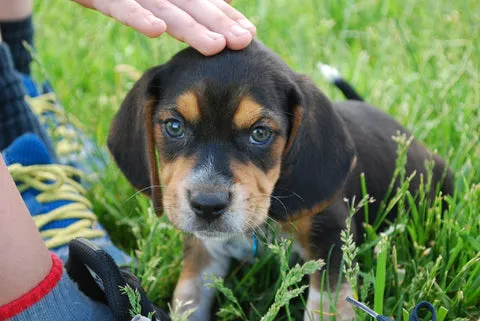 A curious Beagle with its signature floppy ears and tri-color coat, looking intently
A curious Beagle with its signature floppy ears and tri-color coat, looking intently
A Brief History – Beagles are descendants of hounds and were primarily utilized for hunting due to their keen sense of smell and agile, small stature. A unique variety known as ‘pocket beagles’ were small enough to be carried in hunters’ coat pockets, making them incredibly effective in tracking down rabbits, jackals, and pigs. Their history as adept hunters has shaped their energetic and inquisitive nature.
| Features | Details |
|---|---|
| Size | Medium |
| Height | 19 to 22 inches |
| Weight | 10 to 15 kilograms |
| Characteristics | Beagles are muscular dogs characterized by slightly domed skulls, long tails, and squarish muzzles. Their sturdy build and expressive eyes add to their charming appearance, making them instantly recognizable. |
| Group | Hound Group |
| Temperament | Friendly, reserved, confident, docile, gentle, and devoted |
| Exercise | Beagles require a significant amount of exercise, with a minimum of one hour daily. Engaging them in activities with company, whether canine or human, greatly benefits their mental and emotional health. Additionally, Beagles thrive on mental stimulation, making sniffing games and regular introduction of new toys crucial for their overall well-being. |
| Grooming | Beagles possess a smooth double coat and shed moderately throughout the year. Weekly brushing helps remove loose hair and promotes healthy growth. They do not require frequent baths, and their nails should be trimmed regularly to prevent pain and discomfort that can arise from overgrowth. |
| Health conditions | Beagles are susceptible to conditions such as hip dysplasia, epilepsy, luxating patella, and hypothyroidism. Their ears should be cleaned weekly to prevent infections, and regular tooth brushing is necessary for dental hygiene. Vigilant care in these areas can help maintain their health. You might also be interested in the jack russell terrier puppies price in india for another active breed option. |
| Food Doggie Dabbas Recommends | High-Value Training Treats, Fresh Meals (Chicken & Pumpkin, Chicken & Mint, Fish & Dill, Mutton & Parsley), Cheese Jerky, Sardine Oil, Hemp Seed Oil, Freshibble. |
Golden Retriever
Golden Retrievers are undeniably one of the most popular dog breeds in India, cherished for their friendly nature and striking appearance. Decades ago, they were valued by Indian royalty, and today, they remain invaluable assets to dog enthusiasts across the country, making them one of the best dog breeds for families in India. Their gentle disposition and trainability make them ideal companions for various households.
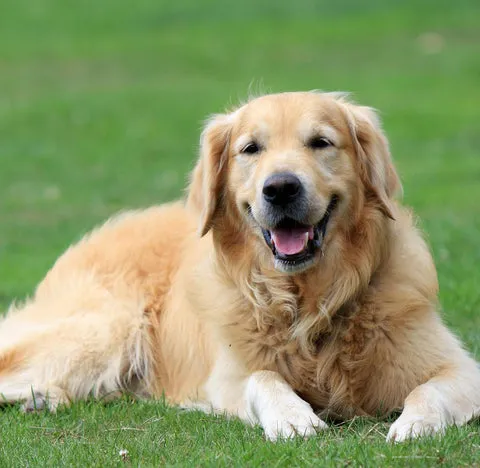 A beautiful Golden Retriever with its characteristic golden, water-repellent coat
A beautiful Golden Retriever with its characteristic golden, water-repellent coat
A Brief History – Primarily bred as bird-dogs for hunting waterfowl, Golden Retrievers were developed through a careful cross of spaniels, setters, Newfoundland dogs, and possibly even a Bloodhound. This unique amalgamation resulted in the creation of a strong-swimming, water-loving dog capable of tracking wounded prey and retrieving crippled birds, embodying a perfect blend of intelligence and athleticism.
| Features | Details |
|---|---|
| Size | Medium to large |
| Height | 21 to 22 inches |
| Weight | 25 to 29 kilograms |
| Characteristics | Golden Retrievers sport fur coats typically in shades of golden, light-golden, and cream. Their water-repellent coats can be either wavy or flat, complemented by feathering on the neck, legs, and thighs, and a broad, robust head. Their lush coat is a hallmark of the breed. |
| Group | Sporting Group |
| Temperament | Intelligent, kind, trustworthy, confident, friendly, and reliable |
| Exercise | Golden Retrievers require abundant exercise to stay healthy and happy. Accompanying their owners on hunting trips, long runs, and bike rides can effectively fulfill their high energy requirements, ensuring they remain physically and mentally stimulated. |
| Grooming | Dogs of this breed shed moderately and continuously. Daily brushing, intensified to twice a day during shedding season, helps remove dead hair and keep the home tidy. Frequent baths are also beneficial for loosening dead hairs and maintaining their cleanliness. As with all breeds, their nails must be kept short to prevent discomfort and potential issues. |
| Health conditions | Golden Retrievers should be screened for hip and elbow dysplasia, retinal atrophy, and heart diseases such as subvalvular aortic stenosis. Regular checks of their ears and teeth are also important to identify and address any signs of infection early. |
| Food Doggie Dabbas Recommends | High-Value Training Treats, Jerky Treats, Fresh Meals. |
Pug
Named after the Latin word meaning ‘clenched fist,’ Pugs are beloved for their charming personalities, earning them immense popularity in India. Despite their small stature, these “big dogs in little bodies” are full of character and affection, making them a favorite choice for many pet owners. Their unique looks and playful demeanor contribute to their widespread appeal.
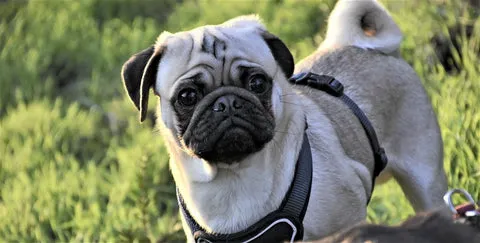 A charming Pug with its distinctive wrinkled face, curled tail, and fawn coat
A charming Pug with its distinctive wrinkled face, curled tail, and fawn coat
A Brief History – Pugs boast a history dating back to 400 B.C., originating in China where they were primarily bred as companions for royalty. They also kept Tibetan Buddhist monks company, and Chinese emperors valued them so highly that they even employed guards for their protection. In India, a notable cellular network advertisement featuring a pug named Cheeka significantly boosted their popularity, and this trend has sustained ever since.
| Features | Details |
|---|---|
| Size | Small |
| Height | 10 to 12 inches |
| Weight | 6 to 10 kilograms |
| Characteristics | The most striking features of Pugs are their small, wrinkled faces and tightly curled tails. The breed has a fine, glossy coat that typically comes in light brown or black, and a compact, square body with well-developed muscles, contributing to their endearing and robust appearance. |
| Group | Toy Dog |
| Temperament | Charming, playful, docile, clever, friendly, and loving |
| Exercise | Pugs require a moderate level of exercise, which can include daily play sessions and leisurely walks in a park. However, Pugs are sensitive to hot weather and should never be subjected to strenuous activity when outdoor temperatures are high, to prevent overheating and respiratory distress due to their brachycephalic (flat) faces. |
| Grooming | Dogs of this breed have a smooth, glossy coat that does not shed excessively. Weekly brushing is sufficient to remove loose hairs. They do not need frequent baths, and their nails should be trimmed to avoid any discomfort. Special attention must be paid to their skin folds, especially after baths, to ensure they are thoroughly dried and kept clean to prevent infections. |
| Health conditions | Pugs are susceptible to hip dysplasia, stenotic nares, corneal ulcers, and dry eyes. Due to their flat faces, they often experience breathing issues like reverse sneezing, particularly in hot and humid conditions. Proactive care and regular veterinary check-ups are important for managing these breed-specific health concerns. Interested readers might also wish to explore medium dog breeds that dont shed a lot for comparison. |
| Food Doggie Dabbas Recommends | Jerky Treats, Supplements (Sardine Fish Oil), Fresh Meals. |
Pomeranian
The Pomeranian is undeniably one of the most unique dog breeds found in India. Historically a favorite of Germany’s Queen Victoria, this lively and loyal breed has become a popular choice for families seeking a spirited and affectionate addition to their home. Their vibrant personality and fluffy appearance make them stand out.
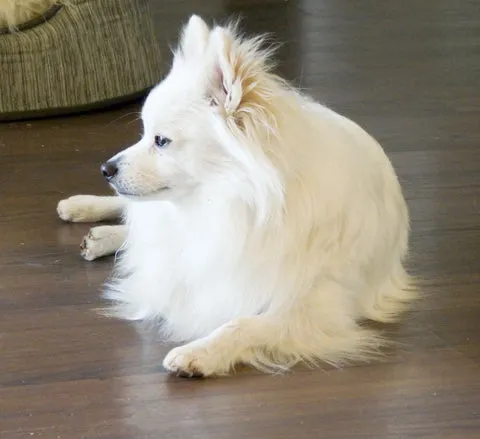 A fluffy Pomeranian with its characteristic thick double coat and foxy face
A fluffy Pomeranian with its characteristic thick double coat and foxy face
A Brief History – Pomeranians are descendants of Arctic dogs, and historically, they were significantly larger than their modern counterparts, capable of working in harsh, cold environments. They were primarily used as sledge and load-carrying dogs, as well as for herding sheep. The breed was named after the Pomerania region, where they were selectively bred down to the smaller size we recognize today.
| Features | Details |
|---|---|
| Size | Small |
| Height | 10 to 11 inches |
| Weight | 2 to 5 kilograms |
| Characteristics | Pomeranians are recognized by their fluffy double coats and foxy faces with alert, prick ears. They have a squarish body shape, and their tails typically curl up and over their back. A thick mane around the neck adds to their distinctive, lion-like appearance, which makes them quite striking. |
| Group | Toy Dog |
| Temperament | Intelligent, playful, sociable, docile, alert, and charming |
| Exercise | Pomeranians require a moderate level of physical activity and thoroughly enjoy running, playing, and going for walks. It is crucial to keep them supervised outdoors, as their small size can unfortunately lead them to be mistaken for small prey animals like rabbits or squirrels by larger, predatory wildlife, making their safety paramount during outdoor excursions. |
| Grooming | Pomeranians are prone to significant shedding and require frequent brushing to maintain their beautiful, dense coat and prevent matting. Engaging a professional groomer is highly recommended for tasks such as bathing, nail trimming, teeth brushing, and ear grooming, as their extensive grooming needs can be challenging for owners to manage consistently on their own. |
| Health conditions | While generally robust, Pomeranians should be screened for health conditions like luxating patellas, collapsing tracheas, seizures, and alopecia. Proactive veterinary care and regular check-ups are key to managing these potential breed-specific health issues and ensuring their overall well-being throughout their lives. |
| Food Doggie Dabbas Recommends | Jerky Treats, High-Value Training Treats, Fresh Meals, Freshibble. |
Shih Tzu
Also affectionately known as the Chrysanthemum Dog or Chinese Lion Dog, the Shih Tzu has seen a considerable increase in demand and availability in India over recent years. Their growing popularity is largely attributed to their exceptional companionship qualities, making them cherished members of many households. Their endearing personality and distinctive appearance make them very desirable pets.
 A small Shih Tzu with its long, flowing coat and a topknot on its head
A small Shih Tzu with its long, flowing coat and a topknot on its head
A Brief History – Shih Tzus originated in Tibet and were revered as symbols of royalty, frequently exchanged as precious gifts among Chinese and Tibetan royalty. The name “Shih Tzu” translates to ‘Little Lion’ in Mandarin, a reference to the God of learning who was believed to travel with a miniature lion dog capable of transforming into a large lion. This rich history underscores their regal status and cultural significance.
| Features | Details |
|---|---|
| Size | Small |
| Height | 9 to 10.5 inches |
| Weight | 4 to 7.5 kilograms |
| Characteristics | Shih Tzus are characterized by a dense, long coat of fur and a heavy volume of hair on their heads. They can be found in various solid colors, including brown or white. Despite their delicate appearance, they possess a muscular build with a deep, broad chest region, adding to their robust yet elegant stature. |
| Group | Toy Dog |
| Temperament | Affectionate, independent, playful, sociable, loyal, and alert |
| Exercise | Shih Tzus require minimal levels of exercise, making them suitable for apartment living. Short daily walks and indoor playtime are generally sufficient to meet their physical activity needs, ensuring they remain healthy and content without requiring extensive outdoor excursions. |
| Grooming | Due to their long coats, Shih Tzus require daily brushing to prevent tangles and mats (which is why they are often considered hypoallergenic dogs, though no dog is truly 100% hypoallergenic). A bath every 10-15 days helps keep them clean. To protect their eyes and prevent irritation, the hair on their head must be carefully trimmed or tied into a topknot. Regular ear cleaning and nail trimming are also essential. Professional grooming is often necessary for their comprehensive care. |
| Health conditions | Shih Tzus are prone to health conditions such as hip dysplasia, cataracts, retinal atrophy, and corneal dryness, and should be regularly screened for these issues. Proactive veterinary care, including regular eye examinations, is important for managing these breed-specific concerns and ensuring their ocular health. |
| Food Doggie Dabbas Recommends | Sardine Oil, Hemp Seed Oil, Fresh Meals, Jerky Treats, Non-Veg lover bundle. |
Siberian Husky
The Siberian Husky frequently wins the title for India’s most unique dog breed, enchanting many with its piercing blue eyes and wolf-like appearance. Their popularity in India has seen a tremendous surge in recent years, despite their origins as classic Northern dogs equipped with built-in winter wear, making them inherently ideal for cold temperatures.
 A majestic Siberian Husky with its thick double coat, erect ears, and striking blue eyes
A majestic Siberian Husky with its thick double coat, erect ears, and striking blue eyes
A Brief History – Siberian Huskies were originally bred in Siberia by the Chukchi people, primarily serving as companions, guard dogs, and sledge dogs. Their fame spread significantly when they were crucial in transporting antitoxins to Nome, Alaska, during a diphtheria epidemic, a heroic feat that cemented their reputation for endurance and loyalty.
| Features | Details |
|---|---|
| Size | Medium-Large |
| Height | 19 to 23 inches |
| Weight | 20 to 35 kilograms |
| Characteristics | Siberian Huskies feature thick manes and a medium-length double coat designed to withstand temperatures as low as -75°F. Their coat colors range from black to pure white, and sometimes include striking red and white combinations. They possess erect ears, straight necks, and a level topline, contributing to their iconic and resilient appearance. |
| Group | Working Group |
| Temperament | Intelligent, friendly, gentle, alert, independent, and sometimes stubborn |
| Exercise | Huskies are highly athletic dogs with significant exercise requirements. As members of the working group, ensuring their physical and mental health necessitates regular, vigorous exercise. Without adequate activity, they may resort to destructive behaviors, highlighting the importance of consistent engagement and outdoor adventures to keep them stimulated. For those who enjoy active breeds, you might also be interested in show me a picture of pit bulls. |
| Grooming | Siberian Huskies are double-coated dogs and are therefore prone to excessive shedding. Daily brushing is essential to manage their coat. They also undergo seasonal shedding (blowing their coat), during which a de-shedding tool is highly recommended due to the heavy volume of hair lost. Despite this, they are remarkably clean animals and do not require frequent baths. Their nails, like any other breed, must be kept short to prevent pain and discomfort. |
| Health conditions | While Siberian Huskies are generally healthy, they can be susceptible to health issues such as juvenile cataracts and hip dysplasia. Regular veterinary check-ups are important for early detection and management of these conditions, ensuring they remain robust throughout their lives. |
| Food Doggie Dabbas Recommends | High-Value Training Treats, Sardine Oil, Hemp Seed Oil, Non-Veg Fresh Meals, Non-Veg lover bundle. |
Dachshund
This distinctive, sausage-shaped dog is certainly a head-turner in India! Dachshunds are celebrated for their lively and playful character, combined with a short coat and small size, which makes them relatively easy to maintain and particularly apartment-friendly. Their unique silhouette and spirited personality quickly win hearts.
 A playful Dachshund, known for its long body and short legs, with a smooth brown coat
A playful Dachshund, known for its long body and short legs, with a smooth brown coat
A Brief History – The name “Dachshund” literally means ‘badger dog,’ a fitting title given their historical role in hunting badgers. These dogs were categorized into two main sizes: standard-sized Dachshunds, which hunted wild boars and badgers, and miniature Dachshunds, primarily used for hunting hares and foxes. Their specialized breeding highlights their courage and tenacity in the field.
| Features | Details |
|---|---|
| Size | Medium-Small (often classified as small) |
| Height | 5 to 9 inches |
| Weight | 3 to 12 kilograms |
| Characteristics | Dachshunds are immediately identifiable by their very long bodies and short legs. They feature broad foreheads, long and pointed noses, floppy ears, curved tails, and deep chests, all contributing to their charming and unmistakable appearance. Their unique physical structure is both their defining characteristic and a point of consideration for their care. |
| Group | Hound Group |
| Temperament | Playful, friendly, lively, alert, independent, stubborn, and clever |
| Exercise | Despite their small size, Dachshunds require regular exercise to stay fit and develop strong muscles, which are crucial for protecting their delicate backs. It is important to prevent them from running up and down stairs or hopping on and off furniture, as these actions can lead to spinal injuries. Consistent, gentle exercise is key to their long-term health. |
| Grooming | Dachshunds do not shed excessively. Smooth-coat Dachshunds require less frequent brushing compared to their long-haired counterparts. As with other breeds, their nails must be kept short to prevent discomfort and potential issues that can arise from overgrown claws. Regular grooming helps maintain their distinctive appearance and overall well-being with minimal effort. |
| Health conditions | Due to their elongated backs, Dachshunds are highly prone to intervertebral disc disease (IVDD), commonly known as a slipped disc. Ample exercise is therefore essential to strengthen their core muscles and prevent this type of damage, as well as obesity. They are also susceptible to ear infections if their floppy ears are not properly maintained and cleaned regularly. |
| Food Doggie Dabbas Recommends | Jerky Treats, Sardine Oil, Hemp Seed Oil, Fresh Meals, Freshibble. |
Indies (Indian Pariah Dog)
Indies, also widely known as Pariah dogs, are an indigenous breed native to the Indian subcontinent. These naturally evolved dogs are commonly found across India and are frequently employed as guard dogs or even police dogs due to their intelligence and protective instincts. Currently, they are a highly popular choice for adoption within the country, valued for their adaptability and loyalty.
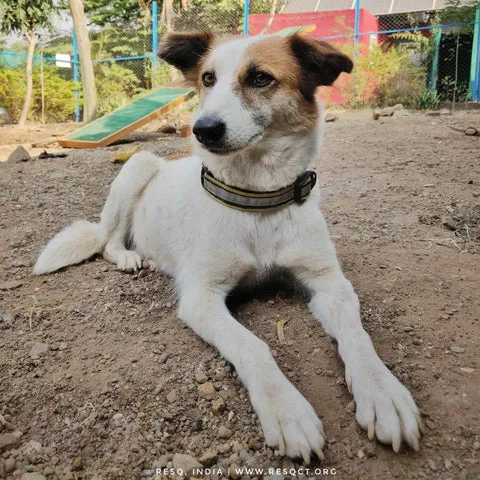 An Indian Pariah Dog (Indie) with its erect ears and short, distinct coatImage source: [Resqct](https://www.resqct.org/images-blog/content/142/Indie%202.jpeg)
An Indian Pariah Dog (Indie) with its erect ears and short, distinct coatImage source: [Resqct](https://www.resqct.org/images-blog/content/142/Indie%202.jpeg)
A Brief History – This ancient breed is distributed throughout South Asia, and while its exact origin remains somewhat unknown, archaeological evidence suggests that these dogs have coexisted with humans for over 12,000 years. Historically, they served as hunting companions for various tribes across the country and are prominently depicted in Indian art, culture, and heritage through sculptures, paintings, and folklore, underscoring their deep roots in the region.
| Features | Details |
|---|---|
| Size | Medium |
| Height | 20 to 25 inches |
| Weight | 12 to 20 kilograms |
| Characteristics | Indies typically have a square or rectangular build and a short double coat, consisting of a soft undercoat and a thick overcoat. They are recognized by their erect ears and a curled tail. The most common coat colors include various shades of light and dark browns, white, black, and reddish-brown, allowing for a diverse range of appearances within the breed. |
| Temperament | Friendly, protective, playful, loving, territorial, and intelligent. These traits make them adaptable companions while also being effective guardians. |
| Exercise | Indies require regular exercise to ensure their physical and mental well-being. They thrive on activities such as walks, runs, and even swims. Without adequate physical and mental stimulation, they may exhibit destructive behaviors. Frequent engagement in sniffing games and other mentally stimulating activities is also crucial for their overall health and happiness. |
| Grooming | Dogs of this breed shed very little and demand minimal attention when it comes to grooming. They generally do not have strong body odors, making occasional baths more than sufficient to keep them clean. While they are well-suited for tropical temperatures, they may not thrive in extreme heat or cold environments. Regular nail trimming is, of course, necessary to prevent pain and discomfort from overgrown claws. |
| Health conditions | The Indian Pariah Dog is recognized as one of the healthiest dog breeds, exhibiting very few to no genetic disorders. Conditions such as hip dysplasia are remarkably rare within this naturally evolved breed, a testament to their robust genetic makeup and adaptability to the local environment. This inherent hardiness makes them a remarkably resilient and low-maintenance choice for dog owners. |
| Food Doggie Dabbas Recommends | Chicken Jerky, Fresh Meals, Training Treats, Sardine Oil. |
Frequently Asked Questions About Dog Breeds in India
Choosing a dog in India involves considering various factors, from diet to climate suitability. Here are some common questions prospective dog owners often ask:
Which dog food is famous in India?
Boiled chicken and rice, along with milk and roti, are popular traditional choices for dog food in India. For those who opt against home-cooked diets, kibble is a common alternative. However, feeding your dog solely rice and chicken for extended periods may not be ideal, as dogs require a diet rich in protein for optimal health. For more detailed information on canine nutrition, you can explore resources like this video guide.
Which dog breed is better for a family in India?
For dog lovers and prospective puppy adopters in India, popular and family-friendly dog breeds include Labradors, Golden Retrievers, Pugs, and Indian Pariah Dogs (Indies). Siberian Huskies, while beautiful, are generally not recommended due to their adaptation to cold climates, which can be detrimental in India’s predominantly tropical environment.
Which is the best suited small breed dog in India?
If you are seeking a small, easy-to-care-for, and apartment-friendly dog in India, excellent choices include Shih Tzus, Indian Spitzs, Pugs, Dachshunds, and Yorkshire Terriers. These breeds adapt well to smaller living spaces, provided their specific exercise and grooming needs are met.
